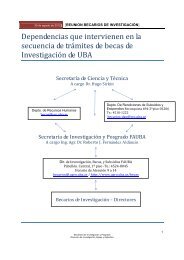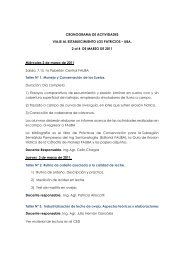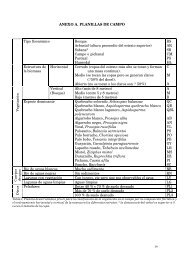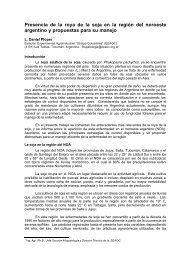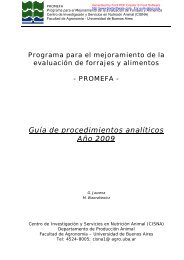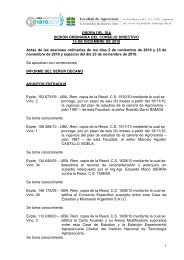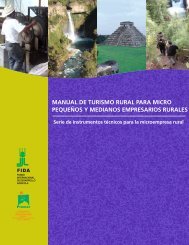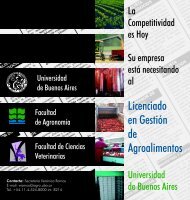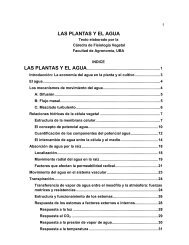Biotechnological processes for conversion of corn into ethanol
Biotechnological processes for conversion of corn into ethanol
Biotechnological processes for conversion of corn into ethanol
You also want an ePaper? Increase the reach of your titles
YUMPU automatically turns print PDFs into web optimized ePapers that Google loves.
Appl Microbiol Biotechnol (2005) 67: 19–25<br />
DOI 10.1007/s00253-004-1819-8<br />
MINI-REVIEW<br />
R. J. Bothast . M. A. Schlicher<br />
<strong>Biotechnological</strong> <strong>processes</strong> <strong>for</strong> <strong>conversion</strong> <strong>of</strong> <strong>corn</strong> <strong>into</strong> <strong>ethanol</strong><br />
Received: 15 July 2004 / Revised: 11 October 2004 / Accepted: 15 October 2004 / Published online: 14 December 2004<br />
# Springer-Verlag 2004<br />
Abstract Ethanol has been utilized as a fuel source in the<br />
United States since the turn <strong>of</strong> the century. However, it has<br />
repeatedly faced significant commercial viability obstacles<br />
relative to petroleum. Renewed interest exists in <strong>ethanol</strong> as<br />
a fuel source today owing to its positive impact on rural<br />
America, the environment and United States energy<br />
security. Today, most fuel <strong>ethanol</strong> is produced by either<br />
the dry grind or the wet mill process. Current technologies<br />
allow <strong>for</strong> 2.5 gallons (wet mill process) to 2.8 gallons (dry<br />
grind process) <strong>of</strong> <strong>ethanol</strong> (1 gallon = 3.785 l) per bushel <strong>of</strong><br />
<strong>corn</strong>. Valuable co-products, distillers dried grains with<br />
solubles (dry grind) and <strong>corn</strong> gluten meal and feed (wet<br />
mill), are also generated in the production <strong>of</strong> <strong>ethanol</strong>.<br />
While current supplies are generated from both <strong>processes</strong>,<br />
the majority <strong>of</strong> the growth in the industry is from dry grind<br />
plant construction in rural communities across the <strong>corn</strong><br />
belt. While fuel <strong>ethanol</strong> production is an energy-efficient<br />
process today, additional research is occurring to improve<br />
its long-term economic viability. Three <strong>of</strong> the most<br />
significant areas <strong>of</strong> research are in the production <strong>of</strong><br />
hybrids with a higher starch content or a higher extractable<br />
starch content, in the <strong>conversion</strong> <strong>of</strong> the <strong>corn</strong> kernel fiber<br />
fraction to <strong>ethanol</strong>, and in the identification and development<br />
<strong>of</strong> new and higher-value co-products.<br />
Background<br />
The production <strong>of</strong> <strong>ethanol</strong> from <strong>corn</strong> <strong>for</strong> use as a<br />
transportation fuel is a mature technology. It was first<br />
introduced in the United States in the early 1900s. The<br />
early Ford Model T had a carburetor adjustment that<br />
allowed the vehicle to run on either gasoline or <strong>ethanol</strong><br />
R. J. Bothast (*) . M. A. Schlicher<br />
National Corn-To-Ethanol Research Center, Southern Illinois<br />
University Edwardsville,<br />
400 University Park Drive,<br />
Edwardsville, IL 62025, USA<br />
e-mail: rbothas@siue.edu<br />
Tel.: +1-618-6596737<br />
Fax: +1-618-6598762<br />
produced by American farmers. Henry Ford’s vision was<br />
to build a vehicle that was af<strong>for</strong>dable to the working<br />
family and powered by a fuel that would boost the rural<br />
farm economy (Kovarik 1998).<br />
Ethanol was used as a fuel source <strong>for</strong> cars well <strong>into</strong> the<br />
1930s. Post World War II, however, little interest remained<br />
in using agricultural crops <strong>for</strong> liquid fuel production<br />
because <strong>of</strong> the abundant and cheap supply <strong>of</strong> fuel from<br />
petroleum and natural gas. Renewed interest in <strong>ethanol</strong><br />
developed in the 1970s with oil supply disruptions from<br />
the Middle East and the phase-out <strong>of</strong> lead as an octane<br />
booster <strong>for</strong> gasoline (Hunt 1981). Additional Federal and<br />
State tax incentives helped fuel the revitalization <strong>of</strong> the<br />
<strong>ethanol</strong> industry from production volumes <strong>of</strong> 10×10 6<br />
gallons in 1979 to 2.81×10 9 gallons in 2003 (1 gallon =<br />
3.785 l; Anonymous 1999, 1981). Together, the passage <strong>of</strong><br />
the Clean Air Act Amendments by Congress in 1990<br />
(which mandated the use <strong>of</strong> oxygenated fuels), questions<br />
concerning the oxygen source methyl tert-butyl ether<br />
(MTBE), and the opportunity to spur rural development<br />
have further accelerated the growth <strong>of</strong> the domestic<br />
<strong>ethanol</strong> industry. With today’s limited oil supplies and<br />
the ever-increasing United States’ dependence on <strong>for</strong>eign<br />
oil (over 62% imported), the need <strong>for</strong> alternative energy<br />
sources is receiving a renewed focus. Fuel <strong>ethanol</strong> remains<br />
an attractive option. Ethanol has strategic value because it<br />
is a renewable energy source and reduces the United<br />
States’ dependence on <strong>for</strong>eign oil imports. It benefits<br />
farmers by creating a substantial new market <strong>for</strong> <strong>corn</strong><br />
supplies and by creating new jobs in economically<br />
depressed rural areas and small communities. As a fuel<br />
component, it burns cleanly and increases the octane level<br />
<strong>of</strong> gasoline. Because <strong>ethanol</strong> has a higher oxygen content<br />
than MTBE, only half the volume is required to produce<br />
the same oxygen level in gasoline; and it is biodegradable<br />
(DiPardo 2000).<br />
Most <strong>of</strong> the current <strong>ethanol</strong> produced in the United<br />
States uses field <strong>corn</strong> as a feedstock. Corn is the most<br />
important and economical source <strong>of</strong> starch in the United<br />
States. Starch is the major carbohydrate storage product in<br />
<strong>corn</strong> kernels comprising 70–72% <strong>of</strong> the kernel weight on a
20<br />
dry weight basis. Starch is readily converted to glucose<br />
and fermented <strong>into</strong> <strong>ethanol</strong>. In 2003, <strong>conversion</strong> to <strong>ethanol</strong><br />
accounted <strong>for</strong> nearly 10 9 bushels <strong>of</strong> <strong>corn</strong>, or 10% <strong>of</strong> the<br />
United States <strong>corn</strong> crop. Projections are <strong>for</strong> <strong>ethanol</strong><br />
demand to reach 5×10 9 gallons by 2012. BBI International<br />
maintains records on current and proposed capacity. As <strong>of</strong><br />
May 2004, they cite 76 currently running <strong>ethanol</strong> plants<br />
(with a capacity <strong>of</strong> over 3×10 9 gallons <strong>of</strong> <strong>ethanol</strong>) and 12<br />
additional plants under construction, adding an incremental<br />
0.5×10 9 gallons in commercial capacity. Tax incentives<br />
and commercial efficiencies are expected to keep pace<br />
with the expected future demand.<br />
The United States Department <strong>of</strong> Agriculture and the<br />
Department <strong>of</strong> Energy at Argonne National Laboratories<br />
have conducted numerous studies on the energy balance <strong>of</strong><br />
<strong>ethanol</strong> production. They both concluded that a gallon <strong>of</strong><br />
<strong>ethanol</strong> produces more energy than the fossil inputs to<br />
produce it (Shapouri et al. 1996; Wang et al. 1997). The<br />
most recently published results by Shapouri indicate an<br />
average (across dry grind and wet mill <strong>processes</strong>) energy<br />
yield <strong>of</strong> 67% more than the fossil inputs required to<br />
produce it (Shapouri et al. 2004). This has been an area <strong>of</strong><br />
significant improvement in <strong>ethanol</strong> production, with<br />
energy requirements at 50% less than what was required<br />
<strong>for</strong> <strong>ethanol</strong> production in the late 1970s. Alternatively,<br />
gasoline yields 20% less energy than the fossil inputs<br />
required to produce it (Shapouri et al. 1996; Wang et al.<br />
1997).<br />
Current <strong>ethanol</strong> production <strong>processes</strong><br />
Today, most fuel <strong>ethanol</strong> is produced from <strong>corn</strong> by either<br />
the dry grind (67%) or the wet mill (33%) process. The<br />
key distinction between wet mill and dry grind facilities is<br />
the focus <strong>of</strong> the resourcing. In the case <strong>of</strong> a dry grind plant,<br />
the focus is maximizing the capital return per gallon <strong>of</strong><br />
<strong>ethanol</strong>. In the case <strong>of</strong> a wet mill plant, capital investments<br />
allow <strong>for</strong> the separation <strong>of</strong> other valuable components in<br />
the grain be<strong>for</strong>e fermentation to <strong>ethanol</strong>.<br />
The wet milling process is more capital- and energyintensive,<br />
as the grain must first be separated <strong>into</strong> its<br />
components, including starch, fiber, gluten, and germ. The<br />
germ is removed from the kernel and <strong>corn</strong> oil is extracted<br />
from the germ. The remaining germ meal is added to fiber<br />
and the hull to <strong>for</strong>m <strong>corn</strong> gluten feed. Gluten is also<br />
separated to become <strong>corn</strong> gluten meal, a high-protein<br />
animal feed. In the wet milling process, a starch solution is<br />
separated from the solids and fermentable sugars are<br />
produced from the starch. These sugars are fermented to<br />
<strong>ethanol</strong>. Wet mill facilities are true “biorefineries”,<br />
producing a number <strong>of</strong> high-value products.<br />
In the dry grind process, the clean <strong>corn</strong> is ground and<br />
mixed with water to <strong>for</strong>m a mash. The mash is cooked and<br />
enzymes are added to convert starch to sugar. Then yeast<br />
is added to ferment the sugars, producing a mixture<br />
containing <strong>ethanol</strong> and solids. This mixture is then<br />
distilled and dehydrated to create fuel-grade <strong>ethanol</strong>. The<br />
solids remaining after distillation are dried to produce<br />
distillers’ dried grains with protein and are sold as an<br />
Fig. 1 Ethanol production <strong>processes</strong>
21<br />
animal feed supplement. A schematic <strong>of</strong> both <strong>processes</strong> is<br />
illustrated in Fig. 1.<br />
Current technologies allow <strong>for</strong> 2.5 gallons (wet mill) to<br />
2.8 gallons (dry grind) <strong>of</strong> <strong>ethanol</strong> per bushel <strong>of</strong> <strong>corn</strong>.<br />
Recent growth in the industry has been predominantly<br />
with dry grind plants, because <strong>of</strong> lower (2× to 4×) capital<br />
costs per gallon and incentives <strong>for</strong> farmer-owned cooperatives<br />
(Shapouri et al. 1996; Wang et al. 1997). The<br />
wet mill industry has largely relied on expanding existing<br />
facilities rather than building new plants. Currently,<br />
59 companies operate the 76 active <strong>ethanol</strong> plants in the<br />
United States today. The majority <strong>of</strong> these are farmerowned<br />
cooperatives or limited liability corporation dry<br />
grind plants. The large-scale wet mill plants are concentrated<br />
among a few predominately publicly held companies<br />
with a long history <strong>of</strong> processing.<br />
To be economically viable, both dry grind and wet mill<br />
plants must obtain value both from the <strong>ethanol</strong> resulting<br />
from the process and from the co-products generated. The<br />
most significant input cost is the cost <strong>of</strong> the starting <strong>corn</strong>.<br />
Commodity <strong>corn</strong> prices from the USDA database are U.<br />
S. $2.32 per bushel (10-year average). The coproducts <strong>of</strong><br />
value are distillers dried grains with or without solubles<br />
(DDGS) from the dry grind process and <strong>corn</strong> oil, <strong>corn</strong><br />
gluten meal, and <strong>corn</strong> gluten feed from the wet mill<br />
process. For every bushel <strong>of</strong> <strong>corn</strong>, 17 pounds <strong>of</strong> DDGS<br />
(1 pound = 0.4536 kg) are generated via the dry grind<br />
process and 1.6 pounds <strong>of</strong> <strong>corn</strong> oil, 2.6 pounds <strong>of</strong> gluten<br />
meal, and 13.5 pounds <strong>of</strong> gluten feed are generated via the<br />
wet mill process. The value <strong>of</strong> these coproducts fluctuates<br />
with available supply and the cost <strong>of</strong> competing<br />
commodity protein sources: primarily <strong>corn</strong>, soybeans,<br />
and soybean meal. According to the USDA, the 7-year<br />
average selling price (per ton) <strong>of</strong> DDGS, <strong>corn</strong> gluten meal,<br />
and <strong>corn</strong> gluten feed are U.S. $126, $357, and $88,<br />
respectively. The 10-year average price <strong>for</strong> <strong>corn</strong> oil (per<br />
pound) is U.S. $0.30. Carbon dioxide is generated via both<br />
<strong>processes</strong>. When it is captured, it is typically sold to the<br />
beverage industry <strong>for</strong> carbonation purposes.<br />
This Mini-Review focuses on the dry grind fuel <strong>ethanol</strong><br />
production process. Dry grind fuel <strong>ethanol</strong> production is<br />
where the majority <strong>of</strong> the fuel <strong>ethanol</strong> industry growth is<br />
today. Further, the majority <strong>of</strong> the ef<strong>for</strong>ts to improve<br />
<strong>ethanol</strong> production focus on taking the biorefinery concept<br />
<strong>of</strong> the wet mill and mimicking it in the dry grind process.<br />
Dry grind <strong>ethanol</strong> production<br />
The dry grind process is designed to ferment as much <strong>of</strong><br />
the <strong>corn</strong> kernel as possible. There are five basic steps in<br />
the conventional dry grind <strong>ethanol</strong> process: grinding,<br />
cooking, liquefaction, saccharification, and fermentation.<br />
Little is wasted in the production <strong>of</strong> this fuel—in addition<br />
to <strong>ethanol</strong>, the manufacturing process also produces<br />
distillers grains, a high-quality livestock feed, and carbon<br />
dioxide, a food and industrial product. In the dry grind<br />
method <strong>of</strong> <strong>ethanol</strong> production, nothing is done to preseparate<br />
the <strong>corn</strong> starch from the kernel. The entire <strong>corn</strong><br />
kernel is ground <strong>into</strong> a coarse flour through a hammer mill,<br />
to pass through a 30 mesh screen, then slurried with water<br />
to <strong>for</strong>m a “mash”. Each bushel <strong>of</strong> <strong>corn</strong> generates<br />
∼22 gallons <strong>of</strong> mash.<br />
Starch <strong>conversion</strong><br />
Starch exists as insoluble, partially crystalline granules in<br />
the endosperm <strong>of</strong> the <strong>corn</strong> kernel. Corn starch is made up<br />
<strong>of</strong> individual units <strong>of</strong> glucose, linked together in chains by<br />
alpha 1–4 and occasional alpha 1–6 linkages. The 1–4<br />
linkages produce linear chains that primarily comprise<br />
molecules called “amylose”, whereas the alpha 1–6<br />
linkages serve as branching points to produce branchedchain<br />
molecules called amylopectin. Normal <strong>corn</strong> starch<br />
contains about 27% amylose, with the remainder being<br />
amylopectin. Starch cannot be metabolized directly by<br />
yeast, but must first be broken down <strong>into</strong> simple six<br />
carbon sugars prior to fermentation. To accomplish this<br />
<strong>conversion</strong>, the pH <strong>of</strong> the mash is adjusted to pH 6.0,<br />
followed by the addition <strong>of</strong> alpha-amylase. A thermostable<br />
alpha-amylase enzyme is added to begin breaking down<br />
the starch polymer to produce soluble dextrins by quickly<br />
and randomly hydrolyzing alpha 1–4 bonds. The mash is<br />
heated above 100°C using a jet cooker, which provides the<br />
high temperature and mechanical shear necessary to cleave<br />
and rupture starch molecules, especially those <strong>of</strong> a high<br />
molecular weight. The <strong>corn</strong> mash is kept at the elevated<br />
temperature <strong>for</strong> several minutes by pumping it through a<br />
holding tube equipped with a backpressure valve. The<br />
mash flows from the holding tube <strong>into</strong> a flash tank and the<br />
temperature is allowed to fall to 80–90°C. Additional<br />
alpha-amylase is added and the mash is liquefied <strong>for</strong> at<br />
least 30 min. Liquefaction greatly reduces the size <strong>of</strong> the<br />
starch polymer. The dextrinized mash is then cooled,<br />
adjusted to pH 4.5, and glucoamylase enzyme is added.<br />
Glucoamylase converts liquefied starch <strong>into</strong> glucose.<br />
Enough glucoamylase is added such that the saccharification<br />
<strong>of</strong> the starch to glucose, which occurs continually<br />
through the fermentation, does not limit the rate <strong>of</strong> <strong>ethanol</strong><br />
production.<br />
Fermentation<br />
After cooking, the mash is cooled to 32°C and transferred<br />
to fermenters where yeast is added. Often, ammonium<br />
sulfate or urea is added as a nitrogen source <strong>for</strong> the growth<br />
<strong>of</strong> yeast. Recently, the <strong>ethanol</strong> dry grind mills have also<br />
begun to add proteases that break down the <strong>corn</strong> protein to<br />
free amino acids, which serve as an additional source <strong>of</strong><br />
nitrogen <strong>for</strong> the yeast. The fermentation requires 48–72 h<br />
and has a final <strong>ethanol</strong> concentration <strong>of</strong> 10–12%. The pH<br />
<strong>of</strong> the beer declines during the fermentation to below<br />
pH 4, because <strong>of</strong> carbon dioxide <strong>for</strong>med during the <strong>ethanol</strong><br />
fermentation. The decrease in pH is important <strong>for</strong><br />
increasing the activity <strong>of</strong> glucoamylase and inhibiting<br />
the growth <strong>of</strong> contaminating bacteria. Dry grind plants can
22<br />
reduce the amount <strong>of</strong> glucoamylase added by saccharifying<br />
the liquefied starch at 65°C prior to fermentation.<br />
Many plants, however, have gone to simultaneous<br />
saccharification and fermentation (SSF) because it lowers<br />
the opportunity <strong>for</strong> microbial contamination, lowers the<br />
initial osmotic stress <strong>of</strong> yeast by avoiding a concentrated<br />
glucose solution, and is generally more energy-efficient. In<br />
addition, it can provide yields <strong>of</strong> up to 8% more <strong>ethanol</strong><br />
per bushel <strong>of</strong> grain. Upon completion, the beer is distilled<br />
through the beer column.<br />
Either batch or continuous fermentation systems may be<br />
used, although batch processing is more common. Some<br />
new fermentation systems are designed to minimize<br />
dilution water, which reduces the evaporation requirements<br />
and thus the energy required in the feed-processing<br />
stages after fermentation.<br />
The carbon dioxide released during fermentation is<br />
<strong>of</strong>ten captured and sold, especially by larger dry grind<br />
facilities. The carbon dioxide is used in carbonating s<strong>of</strong>t<br />
drinks and beverages, manufacturing dry ice, and in other<br />
industrial <strong>processes</strong>.<br />
Distillation and dehydration<br />
Distillation is the process <strong>of</strong> separating the <strong>ethanol</strong> from<br />
the solids and water in the mash. Alcohol vaporizes at<br />
78°C and water at 100°C (at sea level). This difference<br />
allows water to be separated from <strong>ethanol</strong> by heating in a<br />
distillation column.<br />
Conventional distillation/rectification methods can produce<br />
95% pure (190 pro<strong>of</strong>) <strong>ethanol</strong>. At this point, the<br />
alcohol and water <strong>for</strong>m an azeotrope, which means further<br />
separation by heat cannot occur. In order to blend with<br />
gasoline, the remaining 5% water must be removed by<br />
other methods. Modern dry grind <strong>ethanol</strong> plants use a<br />
molecular sieve system to produce absolute (100%, or<br />
200 pro<strong>of</strong>) <strong>ethanol</strong>.<br />
The anhydrous <strong>ethanol</strong> is then blended with approximately<br />
5% denaturant (such as gasoline) to render it<br />
undrinkable and thus not subject to beverage alcohol tax.<br />
It is then ready <strong>for</strong> shipment to gasoline terminals or<br />
retailers.<br />
Stillage processing<br />
The solid and liquid fraction remaining after distillation is<br />
referred to as “whole stillage”. Whole stillage includes the<br />
fiber, oil, and protein components <strong>of</strong> the grain, as well as<br />
the non-fermented starch. This coproduct <strong>of</strong> <strong>ethanol</strong><br />
manufacture is a valuable feed ingredient <strong>for</strong> livestock,<br />
poultry, and fish.<br />
Although it is possible to feed whole stillage, it is<br />
usually processed further be<strong>for</strong>e being sold <strong>for</strong> feed. First,<br />
the “thin stillage” is separated from the insoluble solid<br />
fraction using centrifuges or presses/extruders. The stillage<br />
leaving the beer column is centrifuged with a decanter.<br />
Between 15% and 30% <strong>of</strong> the liquid fraction (thin stillage)<br />
is recycled as backset. The remainder is concentrated<br />
further by evaporation and mixed with the residual solids<br />
from the fermentation. After evaporation, the thick,<br />
viscous syrup is mixed back with the solids to create a<br />
feed product known as wet distillers grains with solubles<br />
(WDGS).<br />
Feed products from stillage processing<br />
WDGS, containing 65% moisture, can be used directly as<br />
a feed product. In fact, it is <strong>of</strong>ten favored by dairy and beef<br />
feeders because cattle seem to prefer the moist texture.<br />
However, WDGS has a shelf-life <strong>of</strong> only 1–2 weeks.<br />
Unless the feedlot is within about 50 miles (80 km) <strong>of</strong> the<br />
<strong>ethanol</strong> plant, handling and storage can be a challenge,<br />
especially in hot summer months when shelf-life is very<br />
limited.<br />
To increase shelf-life and reduce transportation costs,<br />
WDGS is usually dried to 10–12% moisture, to produce<br />
DDGS. Drying WDGS is energy-intensive, consuming<br />
about one-third <strong>of</strong> the energy requirements <strong>of</strong> the entire<br />
dry grind plant. However, producing a uni<strong>for</strong>m, stable,<br />
high-quality feed coproduct is essential to the pr<strong>of</strong>itability<br />
<strong>of</strong> the plant, resulting in most plants producing DDGS<br />
rather than WDGS.<br />
Currently, dry grind <strong>ethanol</strong> plants produce over<br />
3.8×10 6 tons <strong>of</strong> DDGS annually. It is projected that the<br />
volume <strong>of</strong> DDGS will increase to over 5.5×10 6 tons by the<br />
year 2005.<br />
The dry grind <strong>ethanol</strong> production method is a rigorous<br />
biological process that requires stringent quality control.<br />
For example, bacterial contamination at mashing may<br />
result in the <strong>for</strong>mation <strong>of</strong> acids that divert glucose from<br />
<strong>ethanol</strong> production and interfere with fermentation. Moldy<br />
grain, improper grain storage, faulty equipment, reintroduced<br />
stillage, and air are some <strong>of</strong> the major sources<br />
<strong>of</strong> contamination that can reduce <strong>ethanol</strong> yields or impact<br />
the value <strong>of</strong> the distillers grains.<br />
Future directions<br />
A number <strong>of</strong> surveys have been conducted by the<br />
Renewable Fuels Association, the Illinois Corn Growers<br />
Association, and the Iowa Corn Growers Association to<br />
determine the research priorities <strong>of</strong> the industry. The<br />
national priorities in ranked order are: new coproducts,<br />
plant emissions, fermentation, feedstocks, fiber recovery,<br />
DDGS, separation, pretreatment, saccharification, germ<br />
recovery, distillation, starch hydrolysis, and carbon dioxide.<br />
For the sake <strong>of</strong> this review, we highlightd three areas:<br />
high fermentable hybrids, <strong>conversion</strong> <strong>of</strong> fiber (biomass)<br />
component <strong>of</strong> the kernel to <strong>ethanol</strong>, and recovery <strong>of</strong> new<br />
and high-value <strong>ethanol</strong> coproducts with the best near-term<br />
opportunities to produce <strong>ethanol</strong> more cost-efficiently.
23<br />
High fermentable hybrids<br />
There is considerable interest today <strong>for</strong> seed companies to<br />
market specific hybrids bred <strong>for</strong> enhanced <strong>ethanol</strong><br />
production. Corn hybrids are being developed either<br />
with higher extractable starch or with higher fermentable<br />
starch content, <strong>for</strong> wet mill or dry grind <strong>ethanol</strong><br />
production, respectively. Early ef<strong>for</strong>ts are in selective<br />
breeding versus a transgenic approach. The two largest<br />
United States <strong>corn</strong> seed companies, Pioneer and Monsanto,<br />
both have ongoing research ef<strong>for</strong>ts to identify and<br />
develop new <strong>corn</strong> hybrids with these features and to<br />
understand the impact <strong>of</strong> agronomic practices and the<br />
environment on the hybrid characteristics. Additionally,<br />
both have commercial seed <strong>corn</strong> today specifically labeled<br />
<strong>for</strong> the <strong>ethanol</strong> industry. Not yet evaluated in either <strong>of</strong><br />
these programs, but important research to be conducted, is<br />
the impact on the composition <strong>of</strong> coproducts from hybrids<br />
resulting in higher <strong>ethanol</strong> production.<br />
Pioneer’s research ef<strong>for</strong>ts include work to both generate<br />
hybrids more conducive to the <strong>ethanol</strong> production process<br />
and to understand how to optimize these characteristics<br />
under field conditions. Their ef<strong>for</strong>ts to generate hybrids <strong>for</strong><br />
the dry grind industry have resulted in hybrids characterized<br />
by high total fermentables (HTF). Their research has<br />
shown that the HTF trait is a more accurate indicator <strong>of</strong><br />
dry grind <strong>ethanol</strong> production than total starch or<br />
extractable starch. Pioneer has analyzed data from over<br />
15,000 plot samples over 3 years to assign the HTF<br />
designation to specific brands. These hybrids, identified as<br />
Pioneer Industry Select, result in <strong>ethanol</strong> yields up to 4%<br />
greater than a bulk commodity. This could mean an<br />
increase <strong>of</strong> U.S. $1–2×10 6 in pr<strong>of</strong>itability <strong>for</strong> a 40×10 6 -<br />
gallon year −1 <strong>ethanol</strong> production facility. Additionally,<br />
Pioneer has developed a point-<strong>of</strong>-sale assay using wholegrain<br />
near-infrared (NIR) technology that allows <strong>ethanol</strong><br />
plants to predict the value <strong>of</strong> <strong>corn</strong> <strong>for</strong> <strong>ethanol</strong> production<br />
by identifying HTF grain arriving at the plant. These<br />
instruments are provided to plants participating in the<br />
Pioneer program (Butzen et al. 2003; Bryan 2003a, b).<br />
Pioneer’s ef<strong>for</strong>ts to understand the impact <strong>of</strong> agronomic<br />
practices and environmental conditions in optimizing<br />
hybrid production <strong>for</strong> the <strong>ethanol</strong> industry are also<br />
progressing significantly. Their research to-date suggests<br />
an optimum exists <strong>for</strong> grain yield and extractable starch or<br />
total fermentables, based on plant population and applied<br />
nitrogen per acre. Pioneer recommends hybrid selection<br />
<strong>for</strong> yield and agronomics first, followed by the hybrid<br />
designation as either HTF or high extractable starch.<br />
Additionally, their research suggests that managing the<br />
field <strong>for</strong> optimum yield also maximizes extractable starch<br />
or total fermentables (O’Bryan 2004).<br />
Monsanto’s ef<strong>for</strong>ts focus on the dry grind industry. They<br />
have also developed a list <strong>of</strong> hybrids <strong>for</strong> <strong>ethanol</strong><br />
production termed “Processor Preferred Fermentable<br />
Corn”. For the 2004 crop year, these hybrids were <strong>of</strong>fered<br />
in nearly 60 independent seed brands in addition to the<br />
Monsanto DEKALB and Asgrow brands. Additionally,<br />
Monsanto also provides NIR instrumentation to the<br />
23 plants participating in their marketing program (Anderson<br />
2003).<br />
A third area <strong>of</strong> industrial interest is illustrated in the<br />
ef<strong>for</strong>ts <strong>of</strong> Syngenta Biotechnology to direct the accumulations<br />
<strong>of</strong> starch-hydrolyzing enzymes in the endosperm <strong>of</strong><br />
transgenic <strong>corn</strong> kernels (Craig et al. 2004). Stable<br />
accumulations <strong>of</strong> enzymes, without detriment to grain<br />
viability and composition, allows “processing capability”<br />
to be built <strong>into</strong> the grain itself. Self-processing grains can<br />
be designed to meet specific and novel process constraints<br />
due to flexibilities in engineering enzymes with distinct<br />
biophysical properties and enzymatic specificities.<br />
Longer-term ef<strong>for</strong>ts to create modified starches or other<br />
complex carbohydrates from genetically modified <strong>corn</strong> are<br />
intended to provide new functionalities that will make<br />
possible additional markets and products <strong>for</strong> <strong>corn</strong>. These<br />
hybrids may result in starch with improved gelling<br />
properties, viscosity, and temperature stability, improved<br />
flavor or flavor stability, improved adhesion or film<br />
<strong>for</strong>mation, or properties that enhance the efficiency <strong>of</strong><br />
processing.<br />
Fiber <strong>conversion</strong><br />
Fermentation <strong>of</strong> the fiber fraction <strong>of</strong> the <strong>corn</strong> kernel can<br />
increase <strong>ethanol</strong> yield from a bushel <strong>of</strong> <strong>corn</strong> by 10% and<br />
subsequently yield a higher-value and higher-protein feed<br />
coproduct than is typically recovered in <strong>corn</strong> gluten feed<br />
and DDGS (Gulati et al. 1996). Expanding fuel <strong>ethanol</strong><br />
production beyond 10% <strong>of</strong> our liquid transportation needs<br />
will require developing a lower cost feedstock and only<br />
feedstocks containing lignocellulosics are available in<br />
sufficient quantities to substitute <strong>for</strong> starch as an <strong>ethanol</strong><br />
source.<br />
Corn fiber is particularly attractive as a novel source <strong>of</strong><br />
sugars <strong>for</strong> <strong>ethanol</strong> fermentation. Corn fiber has a high<br />
carbohydrate content that can be converted <strong>into</strong> fermentable<br />
sugars and is stockpiled at central locations—in<br />
many cases at existing fermentation facilities. Currently,<br />
most <strong>corn</strong> fiber is incorporated <strong>into</strong> low-value animal<br />
feeds which may face a limited market in the future as<br />
<strong>ethanol</strong> production continues to grow. In addition to using<br />
<strong>corn</strong> fiber as a feedstock <strong>for</strong> <strong>ethanol</strong>, it may serve well as a<br />
feedstock <strong>for</strong> such value-added fermentation products as<br />
lactic acid, xylitol, lycopene, etc. (Leathers 1998). In<br />
addition to the fibrous component <strong>of</strong> the kernel, the rest <strong>of</strong><br />
the <strong>corn</strong> plant (e.g., <strong>corn</strong> stover) could also serve as a<br />
feedstock <strong>for</strong> <strong>ethanol</strong> (Wyman 2003). Corn stover contains<br />
58% carbohydrates and 1.0–1.5 pounds <strong>of</strong> stover are<br />
produced per pound <strong>of</strong> harvested <strong>corn</strong>. Unlike DDGS and<br />
<strong>corn</strong> fiber, collecting and storing <strong>corn</strong> stover represents a<br />
<strong>for</strong>midable challenge. However, fermenting available <strong>corn</strong><br />
stover could conceivably boost <strong>ethanol</strong> production 10-<br />
fold. To date, no commercial process is in operation <strong>for</strong> the<br />
<strong>conversion</strong> <strong>of</strong> <strong>corn</strong> fiber or <strong>corn</strong> stover <strong>into</strong> fuel <strong>ethanol</strong>.<br />
Major technical constraints to commercialization exist<br />
in the <strong>conversion</strong> <strong>of</strong> lignocellulose to <strong>ethanol</strong>. These<br />
constraints are primarily in the areas <strong>of</strong> pretreatment <strong>of</strong> the
24<br />
substrate, enzymatic hydrolysis <strong>of</strong> the substrate to<br />
fermentable sugars and strain development <strong>for</strong> the fermentation<br />
<strong>of</strong> multiple sugars. Development <strong>of</strong> efficient<br />
substrate pretreatments that increase the susceptibility <strong>of</strong><br />
crystalline cellulose and hemicellulose to enzymatic<br />
hydrolysis will reduce the cost <strong>of</strong> producing <strong>ethanol</strong><br />
from lignocellulosic biomass. Pretreatment <strong>of</strong> lignocellulose,<br />
coupled to enzymatic hydrolysis, generates a stream<br />
<strong>of</strong> mixed sugars, including arabinose, glucose, and xylose<br />
(Grohmann and Bothast 1997). However, enzymes <strong>for</strong> the<br />
hydrolysis <strong>of</strong> biomass remain cost-prohibitive (∼U.<br />
S. $0.30 gallon −1 ; Merino and Cherry 2004) and better<br />
enzymes are required. For example, commercial hemicellulase<br />
mixtures are ineffective <strong>for</strong> hydrolyzing <strong>corn</strong><br />
fiber (Hespell et al. 1997). Improved microbial strains to<br />
ferment mixed sugars are also required (Bothast et al.<br />
1999). Industrial yeast strains, used <strong>for</strong> fermenting <strong>corn</strong><br />
starch, are unable to ferment arabinose and xylose; and the<br />
few naturally occurring strains that do ferment pentoses<br />
only grow slowly and produce low <strong>ethanol</strong> yields. Another<br />
challenge is to obtain strains that can tolerate the inhibitory<br />
compounds generated during pretreatment and hydrolysis.<br />
A fiber <strong>conversion</strong> process requires implementation <strong>of</strong> all<br />
unit operations used in biomass <strong>conversion</strong>, i.e. size<br />
reduction, pretreatment, enzymatic saccharification, fermentation,<br />
and product recovery. Last year, the United<br />
States Department <strong>of</strong> Energy and the United States<br />
Department <strong>of</strong> Agriculture announced several winners <strong>of</strong><br />
their joint “Integrated Biomass Solicitation.” Four <strong>of</strong> these<br />
multimillion dollar projects include <strong>conversion</strong> <strong>of</strong> the<br />
cellulosic and hemicellulosic components <strong>of</strong> <strong>corn</strong> fiber to<br />
<strong>ethanol</strong>. All <strong>of</strong> these projects require scale-up validation. It<br />
is this type <strong>of</strong> scale-up validation <strong>for</strong> which the National<br />
Corn-to-Ethanol Research Plant was constructed.<br />
New and higher-value coproducts<br />
As new technologies are implemented, adding value to<br />
coproducts is essential to the pr<strong>of</strong>itability <strong>of</strong> the fuel<br />
<strong>ethanol</strong> business (Anonymous 1999). This will require a<br />
more holistic approach to <strong>ethanol</strong> production in the dry<br />
grind plant. Optimization <strong>of</strong> coproducts and <strong>ethanol</strong> yield<br />
must be considered. A number <strong>of</strong> new <strong>processes</strong> have been<br />
developed in the laboratory. Examples include the quick<br />
germ (Singh and Eckh<strong>of</strong>f 1996), quick fiber (Singh et al.<br />
1999), enzymatic milling (Johnston et al. 2003), and the<br />
COPE Process (Cheryan 2002). These process modifications<br />
may allow cost-effective removal <strong>of</strong> coproducts such<br />
as <strong>corn</strong> oil, zein, germ, pericap fiber, and endosperm fiber<br />
at the beginning <strong>of</strong> the process, prior to fermentation.<br />
Potential benefits <strong>of</strong> these <strong>processes</strong> are: (1) recovery <strong>of</strong><br />
high quality <strong>corn</strong> germ oil and fiber <strong>for</strong> <strong>corn</strong> fiber oil, (2)<br />
an increase in protein quality <strong>of</strong> residual DDGS after<br />
fermentation, and (3) additional production <strong>of</strong> <strong>ethanol</strong> per<br />
batch. All await validation at the pilot scale. Within the<br />
concept <strong>of</strong> “biorefining”, a cadre <strong>of</strong> products can be listed<br />
(Leathers 1998; Wyman 2003). Examples include: <strong>corn</strong><br />
fiber oil, sweeteners, polysaccharides, pharmaceuticals,<br />
nutraceuticals, fibers, biodegradable films, organic acids,<br />
solvents, amino acids, pigments, enzymes, polyols,<br />
vitamins, etc. Also in the coproduct arena, today’s<br />
DDGS feed customers are asking <strong>for</strong> more in<strong>for</strong>mation<br />
than the traditional moisture, protein, fat, and fiber<br />
analyses. Animal nutritionists want complete nutrient<br />
pr<strong>of</strong>iles <strong>of</strong> the ingredients and they want to know the<br />
variability <strong>of</strong> these nutrients and to have the ability to<br />
select which nutrients they need. In Minnesota, a<br />
certification program <strong>for</strong> DDGS has been developed that<br />
is resulting in market premiums <strong>for</strong> certified DDGS<br />
(Bryan 2003a, b). Research projects are underway that<br />
could modify the amino acid composition, protein<br />
composition, or phosphorous content <strong>of</strong> DDGS. DDGS<br />
market expansion beyond cattle to swine, poultry, and<br />
aquaculture is dependent on improving the quality and<br />
consistency <strong>of</strong> the DDGS coproduct. In addition to feed<br />
uses, numerous other uses <strong>for</strong> DDGS are finding their way<br />
to the marketplace. Examples include: deicers, cat litter,<br />
“lick barrels”, worm food, etc.<br />
References<br />
Anderson B (2003) Targeting total growth. Ethanol Prod Mag<br />
2003:38–40<br />
Anonymous (1981) Fuel alcohol: an energy alternative <strong>for</strong> the<br />
1980s. National Alcohol Fuels Commission, Washington, D.C.<br />
Anonymous (1999) Ethanol industry outlook 1999 and beyond.<br />
Renewable Fuels Association, Washington, D.C.<br />
Bothast RJ, Nichols NN, Dien BS (1999) Fermentations with new<br />
recombinant organisms. Biotechnol Prog 15:867–875<br />
Bryan T (2003a) DDGS standardization: smart idea futile idealism.<br />
Ethanol Prod Mag 2003:24–26<br />
Bryan T (2003b) Pioneer ‘rapid assay’ identifies hybrids <strong>for</strong> aboveaverage<br />
<strong>ethanol</strong> production potential. Ethanol Prod Mag<br />
2003:36–38<br />
Butzen S, Haefele D, Hillard P (2003) Corn processing II: dry grind<br />
<strong>ethanol</strong> production, 13. Pioneer Hybrid International, Johnston<br />
Cheryan M (2002) Corn oil and protein extraction method. US<br />
Patent 6433146<br />
Craig JA, Batie J, Chen W, Freeland SB, Kinkima M, Lanahan MB<br />
(2004) Expression <strong>of</strong> starch hydrolyzing enzymes in <strong>corn</strong>. In:<br />
Tumbleson M (ed) Corn: feedstock <strong>of</strong> the future. (Corn<br />
utilization and technology conference proceedings) Corn Utilization<br />
and Technology, Indianapolis<br />
DiPardo J (2000) Outlook <strong>for</strong> biomass <strong>ethanol</strong> production and<br />
demand. Energy In<strong>for</strong>mation Administration, US Department<br />
<strong>of</strong> Energy, Washington, D.C.<br />
Grohmann K, Bothast RJ (1997) Saccharification <strong>of</strong> <strong>corn</strong> fiber by<br />
combined treatment with dilute sulphuric acid and enzymes.<br />
Process Biochem 32:405–415<br />
Gulati M, Kohlmann K, Ladisch MR, Hespell RB, Bothast RJ<br />
(1996) Assessment <strong>of</strong> <strong>ethanol</strong> production options <strong>for</strong> <strong>corn</strong><br />
products. Bioresour Technol 58:253–264<br />
Hespell RB, O’Bryan PJ, Moniruzzaman M, Bothast RJ (1997)<br />
Hydrolysis by commercial enzyme mixtures <strong>of</strong> AFEX-treated<br />
<strong>corn</strong> fiber and isolated xylans. Appl Biochem Biotechnol<br />
62:87–97<br />
Hunt DV (1981) The gasohol handbook, Industrial, New York<br />
Johnston DB, Singh V, Eckh<strong>of</strong>f SR (2003) Use <strong>of</strong> enzymes to<br />
reduce steep time and SO 2 requirements in a maize wet milling<br />
process. US patent 6566125<br />
Kovarik B (1998) Henry Ford, Charles F. Kettering and the fuel <strong>of</strong><br />
the future. Automot Hist Rev 32:7–27<br />
Leathers TD (1998) Upgrading fuel <strong>ethanol</strong> coproducts. SIM News<br />
48:210–217
25<br />
Merino ST, Cherry JR (2004) Summary <strong>of</strong> progress on DOEsupported<br />
cellulose research <strong>for</strong> the production <strong>of</strong> glucose from<br />
cellulosic biomass. In: Tumbleson M (ed) Corn: feedstock <strong>of</strong><br />
the future. (Corn utilization and technology conference<br />
proceedings) Corn Utilization and Technology, Indianapolis<br />
O’Bryan K (2004) Agronomic management <strong>of</strong> <strong>corn</strong> grain starch <strong>for</strong><br />
<strong>ethanol</strong> and high extractable starch production. American<br />
Society <strong>of</strong> Agronomy, Moline<br />
Shapouri HJ, Duffield A, Graboski MS (1996) Energy balance <strong>of</strong><br />
<strong>corn</strong> <strong>ethanol</strong> revisited. In: ASAE (ed) Conference proceedings<br />
liquid fuel conference. ASAE, St. Joseph, pp 253–259<br />
Shapouri HJ, Duffield J, McAloon A, Wang M (2004) The 2001 Net<br />
Energy Balance <strong>of</strong> Corn-Ethanol. In: Tumbleson M (ed) Corn:<br />
feedstock <strong>of</strong> the future. (Corn utilization and technology<br />
conference proceedings) Corn Utilization and Technology,<br />
Indianapolis<br />
Singh V, Eckh<strong>of</strong>f SR (1996) Effect <strong>of</strong> soak time, soak temperature<br />
and lactic acid on germ recovery parameters. Cereal Chem<br />
73:716–720<br />
Singh V, Moreau RA, Doner LW, Eckh<strong>of</strong>f SR, Hicks KB (1999)<br />
Recovery <strong>of</strong> fiber in the <strong>corn</strong> dry grind <strong>ethanol</strong> process: a<br />
feedstock <strong>for</strong> valuable coproducts. Cereal Chem 76:868–872<br />
Wang M, Saricks C, Wu M (1997) Fuel-cycle fossil energy use and<br />
greenhouse gas emissions <strong>of</strong> fuel <strong>ethanol</strong> produced from U.S.<br />
midwest <strong>corn</strong>. Argonne National Laboratory <strong>for</strong> Illinois<br />
Department <strong>of</strong> Commerce and Community Affairs, Argonne<br />
Wyman CE (2003) Applications <strong>of</strong> <strong>corn</strong> stover and fiber. In: White<br />
PJ, Johnson LA (eds) Corn chemistry and technology. American<br />
Association <strong>of</strong> Cereal Chemists, St. Paul, pp723–750






